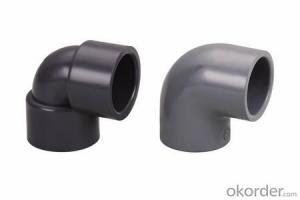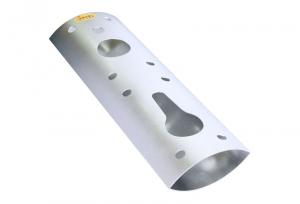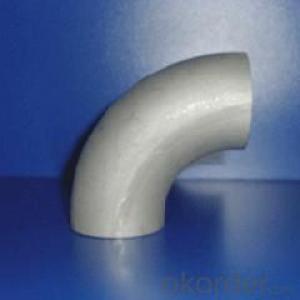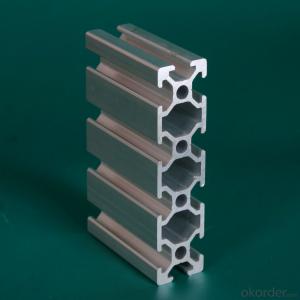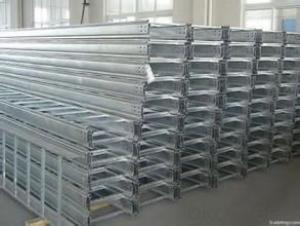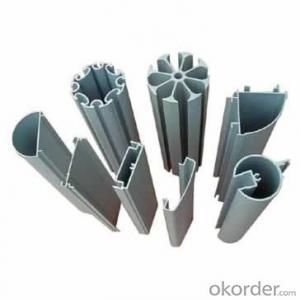45 Degree Aluminum Elbow - Aluminum Extrusion Profiles H Channel for Construction
- Loading Port:
- Shanghai
- Payment Terms:
- TT OR LC
- Min Order Qty:
- 6 m.t.
- Supply Capability:
- 1000 m.t./month
OKorder Service Pledge
OKorder Financial Service
You Might Also Like
Specifications
45 degree aluminum elbow:
Material : carbon steel , stainless steel and alloy steel,
45degree aluminum elbow
Specifications
ASTM B16.9 A234 WPB 90degree 1.5D carbon steel elbow
1.A234 WPB elbow
2.size:1/2"-72"
3.material:A234 WPB
4.API CE ISO
ASTM B16.9 A234 WPB 90degree 1.5D carbon steel elbow
1.A234 WPB elbow
2.size:1/2"-72"
3.material:A234 WPB
4.API CE ISO
Size | 1/2''-24 seamless elbow 26''-72''butt weld elbow |
Wall Thickness | SCH10-SCH160,STD,XS,XXS, GOST , DIN, JIS standard thickness |
Standard | ASTMA234,ASTM A420,ANSI B16.9/B16.28/B16.25,ASME B16.9, JIS B2311-1997/2312, JIS B2311/B2312, DIN 2605-1/2617/2615, GB 12459—99,GOST,EN Standard etc. |
Material | Q235, 20#, 10#, Q345 A234 WPB, WP5, WP9,WP11, ST37.0,ST35.8,ST37.2,ST35.4/8,ST42,ST45,ST52,ST52.4 STP G38,STP G42,STPT42,STB42,STS42,STPT49,STS49 |
Application | Low and middle pressure fluid pipeline,boiler, petroleum and natural gas industry,drilling,chemical industry, electric industry,shipbuilding, fertilizer equipment and pipeline, structure,petrochemical, pharmaceutical industry |
Surface | Sand blasting, black anti-rust oil or galvanized , 3PE,etc. |
Package | Seaworthy Package, Plastic film,Ptywood Wooden Cases or wooden pallet or |
Certificate | ISO9001:2008, CE, API , SGS,BV, etc |
Capacity | 50000tons/year |
Advantages | 1.Reasonable price with excellent quality 2.Abundant stock and prompt delivery 3.Rich supply and export experience, sincere service 4. Reliable forwarder, 2-hour away from port. |
- Q: Can aluminum profiles be used in the production of agricultural equipment?
- Yes, aluminum profiles can be used in the production of agricultural equipment. Aluminum is a versatile and lightweight material that offers several advantages for agricultural applications. It is corrosion-resistant, which is essential for equipment exposed to outdoor conditions and various chemicals used in farming. Additionally, aluminum profiles can be easily shaped and customized to fit specific design requirements, allowing for the creation of complex and functional agricultural equipment. The lightweight nature of aluminum also makes it easier to transport and handle the equipment, reducing labor costs. Moreover, aluminum profiles are recyclable, making them an environmentally friendly choice for agricultural equipment production. Overall, utilizing aluminum profiles in agricultural equipment can enhance durability, efficiency, and sustainability in the farming industry.
- Q: What are the differences between the aluminum profile material and the anodized aluminum profile? Where are they used? If it is necessary to spray the fluorocarbon paint on aluminum, do it on the basis of anodic oxidation or on the aluminum profile material?
- The surface of the material is not oxidized. The oxidized aluminum profile has a smooth and beautiful surface. According to your requirements, choose material
- Q: What are the different surface patterns or textures available for aluminum profiles?
- There are several surface patterns or textures available for aluminum profiles, each offering unique aesthetic and functional qualities. Some of the most common options include: 1. Smooth: This is the most basic and commonly used surface finish, providing a sleek and polished appearance. It is achieved through a process of grinding and polishing the aluminum surface. 2. Brushed: Brushed aluminum profiles have a linear texture that is created by brushing the surface with an abrasive material. This gives the metal a distinctive grain and a slightly matte appearance. 3. Anodized: Anodizing is an electrochemical process that enhances the natural oxide layer on the aluminum surface. This results in a durable and corrosion-resistant finish with a variety of color options. 4. Powder-coated: Powder coating involves applying a dry powder to the aluminum surface and then curing it with heat to create a hard and decorative finish. It can be customized with various colors and textures. 5. Textured: Textured aluminum profiles feature a patterned surface that adds visual interest and can provide improved grip or friction. These patterns can range from subtle to more pronounced, depending on the desired effect. 6. Wood grain: Wood grain finishes are achieved through a process called sublimation, where a high-resolution image of wood grain is transferred onto the aluminum surface. This allows for the appearance of wood without the maintenance requirements. 7. Embossed: Embossed aluminum profiles have raised or recessed patterns that are created through a mechanical or hydraulic process. These patterns can be decorative or functional, providing enhanced grip or structural strength. 8. Diamond plate: Diamond plate is a type of textured finish that features a raised diamond pattern on the surface. It is commonly used in industrial or high-traffic applications for its slip-resistant properties. Overall, the choice of surface pattern or texture for aluminum profiles depends on the specific application, desired aesthetic, and functional requirements. Manufacturers often offer a range of options to cater to varying needs and preferences.
- Q: What is the maximum length of aluminum profiles available?
- The maximum length of aluminum profiles available can vary depending on the supplier and specific requirements, but it is typically around 6 meters (20 feet).
- Q: This question asks for a comparison between aluminum profiles and other materials commonly used for roofing, focusing on their characteristics and performance.
- <p>Aluminum profiles for roofing are known for their durability, corrosion resistance, and lightweight nature. Compared to materials like steel, they are less prone to rust and offer a longer lifespan with minimal maintenance. When compared to traditional materials like wood or clay tiles, aluminum profiles are more resistant to weathering and do not rot or warp. They also have a high strength-to-weight ratio, making them ideal for structures that require lighter roofing materials. Additionally, aluminum profiles can be easily recycled, contributing to sustainability efforts. However, they may not offer the same aesthetic appeal as traditional materials and can be more expensive upfront.</p>
- Q: Can aluminum profiles be used in the construction of curtain walls?
- Curtain walls can indeed utilize aluminum profiles. In fact, aluminum stands as one of the most commonly employed materials for curtain wall systems due to its multitude of advantageous properties. Aluminum profiles possess the ideal combination of lightness and strength, making them perfect for constructing large and structurally sound curtain walls. Moreover, aluminum exhibits high resistance to corrosion, guaranteeing the curtain wall's longevity and durability. It also boasts exceptional versatility, easily taking on various shapes and designs to meet specific requirements and creating visually appealing curtain walls. Furthermore, aluminum profiles effortlessly accommodate different components and features, including glazing, insulation, and ventilation systems. This versatility makes them a popular choice for contemporary curtain wall designs. Additionally, using aluminum profiles enables efficient installation and maintenance processes since they can be prefabricated offsite and promptly assembled on-site. All in all, employing aluminum profiles in curtain wall construction offers numerous benefits in terms of strength, durability, versatility, and aesthetics. Consequently, many architects and builders within the construction industry prefer this material.
- Q: This question asks whether aluminum profiles can be utilized for creating interior partitions and seeks reasons for their suitability.
- <p>Yes, aluminum profiles can be used for interior partitions. They are favored for several reasons: they are lightweight yet strong, offering durability and stability. Aluminum profiles are also resistant to corrosion, which makes them suitable for various environments. Their ease of installation and low maintenance requirements make them cost-effective. Additionally, they can be easily customized to fit various design needs, and their recyclability makes them an environmentally friendly choice.</p>
- Q: What are the regulations and standards that govern the use of aluminum profiles in construction?
- <p>Yes, there are several regulations and standards related to the use of aluminum profiles in construction. These include international standards such as ISO 7039 for anodized aluminum and ISO 9001 for quality management systems. Additionally, regional standards like the European EN 755 for extruded aluminum alloys and the American Architectural Manufacturers Association (AAMA) standards for aluminum products in buildings are crucial. Compliance with these standards ensures the safety, durability, and performance of aluminum profiles in construction applications.</p>
- Q: Are aluminum profiles suitable for exterior cladding systems that need to withstand fire?
- <p>Yes, aluminum profiles can be used for exterior cladding systems that require fire resistance. Aluminum is a non-combustible material, which means it does not support combustion. However, it's important to note that while aluminum itself doesn't burn, it can melt at high temperatures. To enhance fire resistance, aluminum profiles can be coated with intumescent paint or used with fire-resistant materials in the cladding system. These measures can help to slow the spread of fire and protect the structure. Always ensure compliance with local building codes and fire safety regulations when selecting materials for fire-resistant applications.</p>
- Q: Can aluminum profiles be used for stage and truss structures?
- Yes, aluminum profiles can be used for stage and truss structures. Aluminum is a lightweight and durable material that is commonly used in the construction of stage and truss systems. It has excellent strength-to-weight ratio, making it ideal for supporting heavy loads while minimizing the weight of the overall structure. Additionally, aluminum is corrosion-resistant, which is important for stage and truss structures that are often exposed to outdoor elements. Aluminum profiles can be easily assembled and disassembled, allowing for flexibility and ease of transportation. Overall, aluminum profiles are a popular choice for stage and truss structures due to their strength, lightweight nature, durability, and ease of use.
Send your message to us
45 Degree Aluminum Elbow - Aluminum Extrusion Profiles H Channel for Construction
- Loading Port:
- Shanghai
- Payment Terms:
- TT OR LC
- Min Order Qty:
- 6 m.t.
- Supply Capability:
- 1000 m.t./month
OKorder Service Pledge
OKorder Financial Service
Similar products
Hot products
Hot Searches
Related keywords












